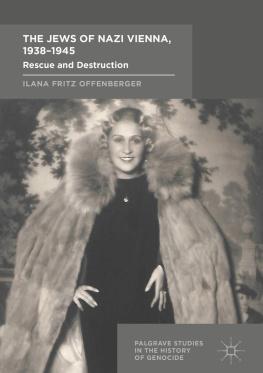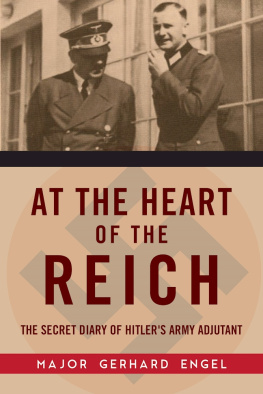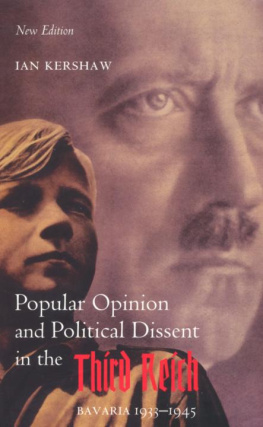2000
The University of North Carolina Press
All rights reserved
Set in Monotype Garamond and Modula types
by Keystone Typesetting, Inc.
Manufactured in the United States of America
The paper in this book meets the guidelines for permanence
and durability of the Committee on Production Guidelines for
Book Longevity of the Council on Library Resources.
Library of Congress Cataloging-in-Publication Data
Bukey, Evan Burr, 1940-
Hitlers Austria : popular sentiment in the Nazi era, 19381945 /
by Evan Burr Bukey.
p. cm.
Includes bibliographical references and index.
ISBN 0-8078-2516-6 (alk. paper)
ISBN 0-8078-5363-1 (pbk.: alk. paper)
1. National socialismAustria. 2. Hitler, Adolf, 1889-1945.
3. AustriaHistoryAnschluss, 1938. 4. AntisemitismAustria.
I. Title.
DB99.B87 1999 99-21475
943.605'22dc21 CIP
cloth 05 04 03 02 01 7 6 5 4 3
paper 05 04 03 02 01 5 4 3 2 1
PREFACE
This book represents an attempt to reconstruct the political attitudes and day-to-day preoccupations of ordinary Austrians under Nazi rule, an empirical effort to glimpse the mental world of those men and women who inhabited what was both Hitlers homeland and between 1938 and 1945 an integral part of his Greater German Reich. It seeks to address questions that have long vexed historians of Central Europe. How popular was the Anschluss? What aspects of National Socialism engendered mass support or opposition? Did traditional religious and political groups remain largely impervious to Nazi ideology? How did the general populace respond to the German war effort? To what extent did Austrians distinguish themselves in the killing machinery of the Third Reich? Were most people neither victims nor perpetrators, a populace that simply stood aside, undefined?
Before examining the main themes of this book, a few words need to be said about the term popular sentiment, an expression that is much discussed but difficult to define. For our purposes, it refers to the collective dispositions of society or what is sometimes called civilian morale. It consists of long-standing assumptions, shared beliefs, and common attitudes. It includes habits of conduct and behavior. It tends to be reactive, subconscious, and politically inert. Popular sentiment differs markedly from public opinion, a term that usually refers to the convictions of those concerned with civic affairsthe politically conscious minority.
In the nineteenth century Karl Marx clearly recognized the importance of mass or popular sentiment in his pungent observation that the tradition of dead generations weighs like a nightmare on the minds of the living.
Historians, however, are relative newcomers to the study of mass opinion. Throughout the ages those most interested in understanding it have been rulers and politicians. They have been the ones most eager to ferret out the views of simple folk, recognizing that political success depends to some degree on popular consent. Plato and Aristotle both called attention to the importance of popular sentiment, and Machiavelli hectored princes to pay due regard to it. While few potentates followed the example of the medieval caliph Harun-al-Rashid, who disguised himself to overhear the complaints and grievances of his subjects, most invariably relied on informers and spies to detect sedition and social unrest.
Still, it was not until the eighteenth century that European monarchs commissioned forces of secret police to oversee the state bureaucracy and to prepare reports on the behavior of individuals. Among the most eager to organize a system of wider surveillance was the Austrian emperor Joseph II, the famous enlightened despot who between 1765 and 1790 tried to streamline the Habsburg monarchy. Thereafter, the French Revolution gave enormous power to state security forces, so that both radical revolutionaries and traditional monarchs utilized their secret police to root out subversion and dissent.
Between 1815 and 1860 the Austrian secret police were commonly regarded as the most effective in Europe. Under the direction of Count Joseph Sedlnitzky they censored the media, intercepted the mail, and monitored the conversations of individuals. One doesnt dare lift his voice here, Beethoven once wrote; otherwise the police find lodging for you. This was a minimalist system of surveillance, one that declined with the liberalization of the monarchy after 1860 but which survived until the dissolution of the Habsburg state in 1918. Two decades later a similar system of observation would be reinstated by the Nazis.
When Hitler seized Austria in 19 3 8, he set his sights on perceived ideological adversaries, primarily Communists, Marxists, Freemasons, Ultramon-taines, the Christian churches, and aristocratic reactionaries. At the same time, he endeavored to mobilize the general population to support his vast plans of conquest. His regime sought to detect popular grievances and to root out their sources, either by crushing cells of ideological resistance or by responding with answers or real solutions.
In incorporated Austria, as in Germany, the Nazis placed the entire population under surveillance, assigning party members the task of reporting suspicious or hostile activity to the Gestapo.
This book, like other examinations of popular sentiment in Nazi Europe, is based largely on the surviving station reports of the Security Service as well as on those of the Landrte, or county executives, and the more irregular observations of the judicial authorities. Reliance on these and other Nazi sources raises obvious methodological challenges, a problem scholars have long recognized and tried to take into account.
One of the most difficult of the obstacles is what the British historian Ian Kershaw has called the problem of intimidation.
Closely related to the problem of intimidation is that of uneven coverage or lacunae. The silences of the reports are, in fact, more evocative than what is said in them.
For the study of Nazi Austria a final difficulty lies in the disparate and scattered nature of the surviving SD records. What follows tries to reproduce the mosaic of opinion as fully and accurately as possible.









